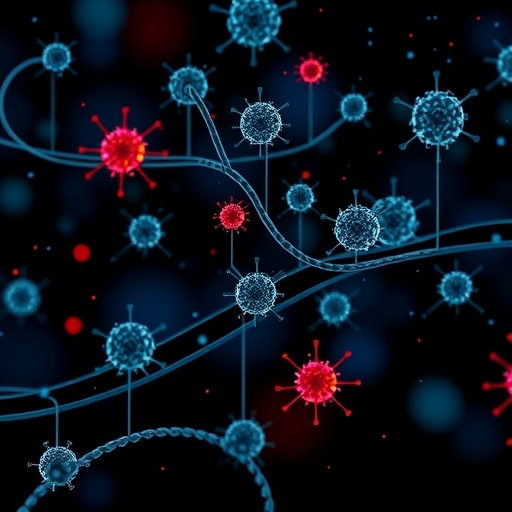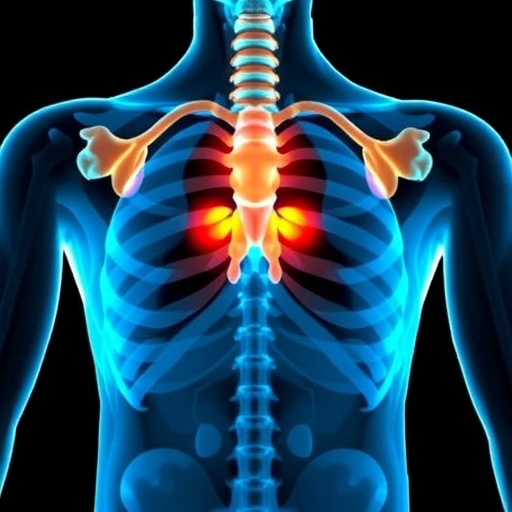
In a groundbreaking pilot study published in BMC Cancer, researchers have explored a novel “watch-and-wait” strategy for managing locally recurrent nasopharyngeal carcinoma (lrNPC) patients who demonstrate an objective response following immuno-chemotherapy. This innovative approach hinges on leveraging low-intensity maintenance treatment (LIMT) to sustain disease remission while potentially deferring or avoiding the need for immediate local therapies, which are often associated with severe toxicities. The findings from this study could reshape treatment paradigms by balancing effective cancer control with quality of life, addressing a critical dilemma faced by clinicians and patients alike.
Nasopharyngeal carcinoma presents unique therapeutic challenges, especially upon local recurrence after initial treatment. Typically, aggressive local treatments such as reirradiation or surgery are employed to salvage patients, but these interventions come with significant risks of debilitating complications. The clinical decision-making process, therefore, involves a delicate trade-off: the chance of eradicating residual cancer versus the likelihood of severe toxicities that may devastate patient well-being. This study embarks on testing a subtler, more patient-friendly route that capitalizes on the tumor’s sensitivity to immune checkpoint inhibitors combined with chemotherapy—an area of growing interest in oncology.
The study took place from January 2022 through May 2023, enrolling twenty-six patients with locally recurrent nasopharyngeal carcinoma at a single institution. All participants received a standardized protocol of immune checkpoint inhibitor (ICI) plus chemotherapy, which has increasingly become an effective backbone for treating various malignancies by enhancing the immune system’s ability to recognize and attack tumor cells. Following this initial phase, patients who had achieved an objective response—defined as a measurable reduction in tumor burden—were transitioned to a maintenance regimen involving low-intensity treatment. Significantly, during this maintenance phase, no immediate local interventions were applied; instead, patients were closely observed under this “watch-and-wait” approach.
.adsslot_AjDBFvJYqd{width:728px !important;height:90px !important;}
@media(max-width:1199px){ .adsslot_AjDBFvJYqd{width:468px !important;height:60px !important;}
}
@media(max-width:767px){ .adsslot_AjDBFvJYqd{width:320px !important;height:50px !important;}
}
ADVERTISEMENT
Remarkably, eighteen patients met the criteria of objective response post-ICI-chemotherapy and proceeded with LIMT alone. Of these, a stunning 94.4% (17 out of 18) managed to maintain disease remission without any need for salvage local treatments such as surgery or radiotherapy during the maintenance period. Only one patient experienced disease progression (PD) during LIMT, underscoring the potential effectiveness of this gentler therapeutic strategy. This finding is particularly compelling as it suggests the possibility of safely deferring invasive therapies in a substantial proportion of patients who respond favorably to systemic treatment upfront.
Beyond response rates, the study reported encouraging survival outcomes. At the two-year mark, overall survival soared to 87.8%, and progression-free survival—the length of time patients remained free from disease worsening—was 64.0%. These statistics offer hope that this “watch-and-wait” approach does not compromise long-term outcomes in well-selected patients. Importantly, the safety profile was favorable. Adverse events related to the treatment were manageable, and no serious treatment-emergent adverse events were noted, which is a meaningful advantage when compared to the often harsh toxicity profiles associated with conventional local therapies.
The rationale for integrating immunotherapy with chemotherapy lies in their synergistic effects. Chemotherapy can induce immunogenic cell death, rendering cancer cells more recognizable to immune cells, while immune checkpoint inhibitors unleash the immune system’s full potential by blocking inhibitory receptors such as PD-1. This dual-pronged attack enhances tumor eradication systemically, potentially reducing tumor burden to levels where local interventions may be deferred safely. The study’s authors suggest that continuing with low-intensity treatment post-response may sustain immune system vigilance, limiting the risk of early relapse.
Clinicians face complex decisions regarding when and how to escalate treatment intensity for recurrent nasopharyngeal carcinoma. Traditionally, immediate local treatment following any residual disease or suspicion of recurrence has been the standard due to concerns around rapid tumor progression. However, this comes at a cost frequently borne by the patients—in terms of mucosal damage, cranial nerve injury, and other debilitating sequelae. The promise of a “watch-and-wait” strategy provides a balanced alternative, potentially delaying these interventions without compromising disease control, thereby improving patient quality of life and preserving functional outcomes.
While this study represents a pioneering step, it is crucial to emphasize its pilot nature. Conducted with a relatively small cohort and limited follow-up duration, the findings must be interpreted with cautious optimism. The authors advocate for well-designed, prospective clinical trials comparing this strategy head-to-head with conventional protocols involving immediate local salvage therapy. Such trials would be instrumental in validating the broader applicability and identifying patient subgroups most likely to benefit from this tailored approach.
The implications of sparing or delaying aggressive local treatment extend beyond toxicity minimization. Reduced need for surgeries or reirradiation can significantly lower healthcare costs and resource utilization, factors that are increasingly relevant in oncology care globally. Moreover, a “watch-and-wait” approach aligns with precision medicine’s ethos, customizing treatment intensity to individual tumor biology and response patterns rather than a one-size-fits-all framework.
This study adds to accumulating evidence advocating for immunotherapy’s expanding role in traditionally challenging oncologic contexts. By harnessing the immune system’s specificity and memory, therapies such as checkpoint inhibitors not only tackle existing disease but may also establish durable anti-tumor immunity, possibly transforming recurrent cancers into manageable chronic conditions. Importantly, the maintenance phase’s low-intensity treatment serves to sustain this immune activation while minimizing toxicity risks, enhancing the overall therapeutic window.
Notably, six patients in the study displayed stable disease at the end of initial ICI-chemotherapy, with two patients experiencing disease progression during this phase. These cases highlight the heterogeneity of tumor responses and underscore the necessity for precise biomarkers to select patients suitable for the “watch-and-wait” strategy. Developing such predictive tools remains a critical area of ongoing research to optimize individualized care pathways.
Safety remains paramount in introducing any novel cancer treatment strategy. Encouragingly, the study reports that all adverse events encountered during LIMT were manageable and lacked severe consequences. This is a vital consideration, given that patients with recurrent nasopharyngeal carcinoma often endure cumulative toxicities from prior treatments. Preservation of organ function and minimization of symptom burden are essential components of holistic cancer care.
The concept of “watch-and-wait” has precedent in other malignancies, such as rectal and certain lymphomas, where careful observation following initial response has been shown to maintain disease control while sparing patients from overtreatment. Translating these principles to recurrent head and neck cancers reflects a broader trend of balancing efficacy with patient-centered outcomes, marking a paradigm shift in oncology.
Integrating findings from this pilot study into clinical practice could initially facilitate shared decision-making discussions between oncologists and patients. Transparency about the benefits and risks of deferring local therapy post-immuno-chemotherapy may empower patients to participate actively in managing their disease trajectory, aligning treatment decisions with their values and preferences.
In conclusion, the study sets a promising foundation for revising management strategies in locally recurrent nasopharyngeal carcinoma. By combining the potency of immune checkpoint inhibitors and chemotherapy with a cautious watchfulness mediated via low-intensity maintenance treatment, this approach holds potential to maximize survival while minimizing harm. Future large-scale trials will be pivotal in confirming these findings and refining protocols, potentially establishing new standards of care that prioritize patient quality of life without compromising disease control.
Subject of Research: Watch-and-wait strategy using low-intensity maintenance treatment after immuno-chemotherapy in locally recurrent nasopharyngeal carcinoma.
Article Title: Watch-and-wait strategy in patients with objective response after immuno-chemotherapy for locally recurrent nasopharyngeal carcinoma: a pilot study.
Article References:
Zhang, Q., Huang, W., Chen, X. et al. Watch-and-wait strategy in patients with objective response after immuno-chemotherapy for locally recurrent nasopharyngeal carcinoma: a pilot study. BMC Cancer 25, 1255 (2025). https://doi.org/10.1186/s12885-025-14647-2
Image Credits: Scienmag.com
DOI: https://doi.org/10.1186/s12885-025-14647-2
Tags: cancer treatment decision-makingchallenges in nasopharyngeal carcinoma treatmentclinical trial for nasopharyngeal carcinomaImmune checkpoint inhibitors in cancer therapyimmuno-chemotherapy for nasopharyngeal carcinomainnovative approaches to cancer recurrencelocally recurrent nasopharyngeal carcinoma managementlow-intensity maintenance treatment in oncologyminimizing toxicities in cancer carenovel cancer management strategiespatient quality of life in cancer therapywatch-and-wait strategy in cancer treatment





